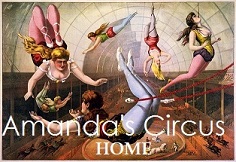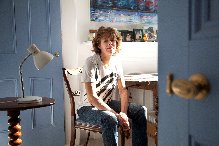Talking to Lucy Ash
Lucy Ash’s latest piece for Winchester Cathedral, as part of 10 Days, is a triptych that examines the three components of chalk: carbon, oxygen and calcium. I’m thrilled that Lucy has taken time out of her busy schedule to talk about her work.
Amanda: Lucy, I find your paintings draw me in. They’re beautiful and enticing. They have a jewel-like quality, a sort of glow. Each segment is like a window in which you can get lost, and because the painting is divided, you can view it in many different ways.
I’d love to know what it is that fascinates you about this form. Are you telling us something or inviting us in?
Lucy: I think every good painting invites you in and encourages you to wander about, whatever the form. But working with segments allows me to look at something in lots of different ways and suggests a sense of time. It’s also a helpful device given the scale of these paintings. When viewing, it is impossible to take everything in at once. Every time you look at the work your eyes see different elements, I want the audience to create their own relevance rather than me tell them.
A: How did you approach the theme of ‘Chalk’? To many of us the science of it, the chemistry, is uncompromisingly abstract and difficult, can you explain what it is that absorbs you about this and why you took this route? Does the abstraction confine you or free you creatively?
L: I like to think quite deeply about any work I engage with. To be honest, initially I thought that this was going to be a very a difficult subject to engage with in an interesting way. In the back of my mind I knew I wanted to paint a triptych, so when I made the discovery that chalk was made up out of three elements – carbon, oxygen and calcium – I was very excited, and everything just fell into place. Interestingly as it turns out I think this piece is more poetic than abstract and may be the start of something new.
A: That is very exciting. Just to clarify, by ‘poetic’, do you mean conveying an emotion or atmosphere?
L: I mean poetic in the way that I experience it in the work of painters like Kandinsky, Gauguin and Doig.
A: I think I understand. It’s a wonderful way of explaining it. I’m interested in the range of colours you use. How did you decide on this? Are they different for each part of the triptych? What are you thinking of as you paint?
L: Each of the elements I have created is subtly different in colour but close in tone – the colour is muted and reflects their different natures, but I am conscious that the three paintings must work as one piece. My process is intuitive, I do not think when I paint, I am painting, I am just engaged in what I am doing. The triptych is also about the texture, I wanted it to feel tactile in the way that chalk is.
A: I love that you’re not thinking. It’s rather like playing a musical instrument, isn’t it. Is the difference between each painting subtle to you? How did you explore the character of each chemical?
L: There is quite a difference between each element, but it’s complex because they are interdependent and also have overlap. I have done quite a bit of background research on each of the elements; enough to get a good sense of their individual natures and get a good feel for them.
A: Your paintings will be exhibited in Winchester cathedral, surrounding Bishop Gardner. How do you feel about the location?
L: I feel very comfortable with the location. The space lends itself to a triptych as it divides into three arches with the bishop located in the centre. He was a great adapter in his life so I am sure that he would be happy to be lying beneath the three components of chalk, the ancient, slow formation and dissolution of chalk is part of the cycle of life.
A: That’s a marvellous way of looking at it. Can you tell us a bit about your creative process? What sort of preliminary work is involved? How do you know when you’re ready to start painting? How can you tell when to stop?
L: I tend to do quite a bit of research about the subject I am going to paint. In this instance I knew very little about these elements, so there was a lot of ground to cover, but there is a limit to this and at some point you just have to get started. I then created sketches that I am working with so I have a sense of what I am painting about. I take Picasso’s advice about when to stop and that is to stop before I finish. It’s great advice.
A: Yes, but I’ve been thinking about whether I can apply that to writing. But somehow I don’t think I can. What’ would you say, are your influences? What inspires you?
L: A broad range of painters that tend to be stylistically expressionistic or poetic, I am interested in inner feelings and ideas expressed emotionally – from Kandinsky, Picasso, Pollock, Basquiat, Polke, Richter, Kiefer and I also love Peter Doig. I like stories of people who have achieved great things against the odds and against injustice as well as music.
A: Now you mention it, I can see a little of Peter Doig in one of your paintings. He’s a favourite of mine. Where do you work? What’s your working routine?
L: I have a purpose made studio in my home. My normal routine is to get up around 6.30-7.00, walk across the common to the gym for half an hour or so (nothing too exerting) and then start work about 9.30 – 10. I then work through to 7 or 8 in the evening. If I have difficult deadlines the routine goes to pot and I get up and go straight to work. It’s not sustainable as a routine.
A: That’s a hard day’s work. I imagine you must be exhausted. What else are you working on?
L: I’ve been working on a piece for the Mall Galleries. For a show called ‘What is the Point’. My artwork celebrates the Irish yes vote for Gay marriage.
A: Fantastic! I’ll be looking out for that. I understand that your triptych is part of a collaboration with Kathy Oldridge whose film will be shown in The Hub at the Discovery Centre, Winchester. Seeing the relationship between Kathy’s film and your paintings will be compulsive viewing.
L: I hope so! We want to use painting and film in a complementary, layered way to explore how each of these mediums allow us to gain different impressions of the same basic ingredients.
A: Thank you, Lucy, for giving so much thought to my questions, and for taking time out of your busy schedule, it’s been absolutely fascinating to discover more about your work and your process. I can’t wait to see your paintings in Winchester Cathedral in October.
∗
Lucy Ash is an abstract painter and filmmaker who draws on her life’s experience to express her emotional response to love, death and injustice. Mathematics, time and the battle against the odds thrown by life are key themes.
Lucy has exhibited internationally including ‘one woman’ and group exhibitions in London and New York. Her one woman show ’49 Frames of Love’ was transferred from the William Road Gallery, London to The Heartbreak Gallery in Marylebone London in 2012. Invited to contribute to 10 days ‘Creative Collisions’ October 2013, Winchester Cathedral and to ‘Art for Youth’ at the RCA, Kensington 2014. In May 2015 ‘In the Wriggle Room’ a series of paintings that respond to the spontaneity and vitality of Jazz music was exhibited at the Stash Gallery, London. This was followed in September by ‘What is the Point’ a group show at the Mall Galleries, London. She has done a number of commissions for companies most notably the Sony Radio Academy Awards brand identity. Her cookbook ‘A Taste of Astrology’ (Knopf 1988, Sainsbury’s 1993) was also serialized by Gourmet Magazine USA.
Originally a student at Central St Martins she also studied at Camberwell College of Art. Lucy was born in London where she lives and works. Her most recent work deals with the importance of equality and compassion in the world.

